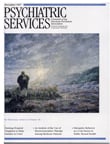Hallucinations, Delusions, and Thought Disorder Among Adult Psychiatric Inpatients With a History of Child Abuse
Abstract
OBJECTIVE: The relationship between three positive symptoms of schizophrenia—hallucinations, delusions and thought disorder—and childhood physical and sexual abuse among psychiatric inpatients was investigated. METHODS: From the records of 100 consecutive admissions to an acute psychiatric inpatient unit in a New Zealand general hospital, the records of the 22 patients in which a history of either physical or sexual childhood abuse was mentioned were examined for data on the frequency and content of hallucinations, delusions, and thought disorder. RESULTS: Seventeen of the 22 patients exhibited one or more of the three symptoms. Half of the symptoms for which content was recorded appeared to be related to the abuse. An analysis of the relationships between types of abuse and specific symptoms suggested that hallucinations may be more common than delusions or thought disorder among patients who have been sexually abused, particularly among those who have experienced incest, and that delusions may be more related to having been physically abused. CONCLUSIONS: The study findings confirmed previous findings of a high frequency of auditory hallucinations, particularly command hallucinations to kill oneself, and paranoid ideation among inpatients with a history of abuse. The hypothesis that the hallucinations of abuse survivors are "pseudohallucinations" was not supported.



